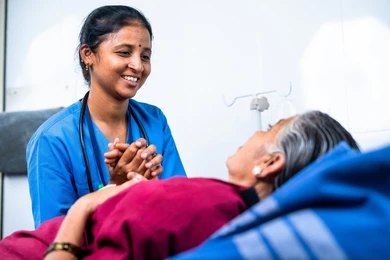Introduction:
Cardiac Bypass Surgery, also known as CABG, is a life-saving procedure for elderly patients with severe coronary artery disease. While the surgery improves blood flow to the heart, recovery can be challenging, especially for seniors. A well-structured CABG care plan is essential to ensure a smooth recovery and prevent complications.
From post-CABG care at home to managing medications and participating in cardiac rehabilitation, every step plays a role in helping elderly patients regain their strength and independence. This article provides a clear roadmap for recovery after heart bypass surgery, addressing everything from wound care to emotional well-being.
Wound Care After CABG Surgery
Proper wound care is crucial for preventing infections and promoting healing. After CABG surgery, patients will have an incision on the chest and possibly on the leg (if a vein was taken for the bypass). Here’s how to care for these wounds:
Keep the wound clean and dry:
Avoid soaking in water; stick to sponge baths until the doctor permits showering.
Check for signs of infection:
Redness, swelling, warmth, pus, or a foul smell from the wound could indicate an infection. Fever and increased pain are also warning signs.
Wear loose, breathable clothing:
This helps prevent irritation and allows the wound to heal properly.
Follow doctor’s instructions on dressing changes:
Some patients may require regular dressing changes, while others may have dissolvable stitches that need minimal care.
If there are concerns about slow healing, consult a doctor promptly as delayed wound healing is more common in elderly patients, especially those with diabetes.
Common Medications Ordered Post-CABG
After CABG surgery, medications are prescribed to prevent complications and support heart health. These may include:
Blood thinners (Aspirin, Clopidogrel)
– Prevent blood clots in the bypassed arteries.
Beta-blockers (Metoprolol, Atenolol)
– Help regulate heart rate and reduce blood pressure.
Statins (Atorvastatin, Rosuvastatin)
– Lower cholesterol levels to prevent further blockages.
Diuretics (Furosemide, Spironolactone)
– Reduce fluid retention and ease heart function.
Pain relievers
– Typically mild painkillers like Paracetamol are given for post-surgical discomfort.
Elderly patients must take medications exactly as prescribed. A medication schedule can help avoid missed doses. In case of dizziness, excessive bleeding, or breathing difficulties, consult a doctor immediately.
Cardiac Rehabilitation
A structured CABG care plan includes cardiac rehabilitation, a supervised program designed to improve heart health and restore strength after surgery.
Risk Categories for Exercise
Doctors assess patients based on their risk levels before recommending exercises:
Low-risk patients
– Can start with mild to moderate exercise soon after surgery.
Moderate-risk patients
– Need careful monitoring, as they may have additional conditions like high blood pressure or diabetes.
High-risk patients
– Require medical supervision before beginning any physical activity.
Exercise Plan
Regular movement prevents complications like blood clots and muscle weakness. Safe exercises for elderly patients include:
Walking:
Start with short walks and increase duration gradually.
Breathing exercises:
Helps improve lung function post-surgery.
Gentle stretching:
Reduces stiffness and improves mobility.
Light resistance training:
Strengthens muscles under medical guidance.
Patients should stop exercising if they feel chest pain, dizziness, or extreme fatigue. Always follow the doctor’s advice for post-CABG care.
Reducing Cardiac Risk Factors After Surgery
While CABG surgery restores blood flow, it doesn’t cure heart disease. To prevent future blockages, it’s crucial to adopt a heart-healthy lifestyle:
Quit smoking
– Smoking damages arteries and increases the risk of another heart attack.
Follow a balanced diet
– A diet rich in fruits, vegetables, whole grains, and lean proteins helps control cholesterol and blood pressure.
Monitor blood sugar levels
– Diabetes management is essential to prevent complications.
Control stress
– Meditation, yoga, or engaging in hobbies can help reduce stress.
Maintain a healthy weight
– Extra weight puts strain on the heart.
Following these steps can significantly improve long-term heart health and reduce the need for another heart bypass after-care procedure.
Emotional and Mental Health Post-CABG
Recovery is not just physical—mental well-being is equally important. Many elderly patients experience mood swings, anxiety, or depression after surgery. Common concerns include:
- Fear of another heart attack
- Feeling dependent on caregivers
- Difficulty returning to daily activities
Support from family, counseling, and joining a cardiac support group can help. If symptoms of depression persist for more than a few weeks, seeking professional help is recommended.
Long-term Care Considerations for Elderly Patients
Long-term post-CABG care at home involves monitoring for complications like:
Heart rhythm problems
– Some patients may require medications or a pacemaker.
Cognitive changes
– Some elderly patients experience memory issues after surgery.
Reduced mobility
– Regular physical activity and physiotherapy can help.
Routine follow-ups with the cardiologist are necessary to track recovery and adjust medications if needed. Family members should ensure a safe home environment, with easy access to essential items and minimal fall risks.
Conclusion
Recovering from CABG surgery requires patience, a structured CABG care plan, and consistent follow-ups. Proper post-CABG care at home, adherence to medications, cardiac rehabilitation, and lifestyle changes are key to a successful recovery. While challenges exist, a supportive environment and proactive care can help elderly patients regain their independence and lead a healthier life.

